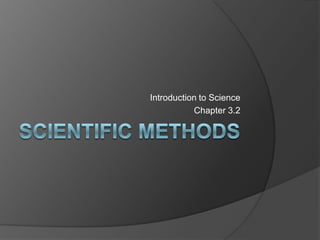
Introduction to Science 3.2 : Scientific Methods
- 1. Scientific methods Introduction to Science Chapter 3.2
- 2. Objectives: Explainwhat scientific methods are. Explain how scientific methods are used to answer questions. Describehow a hypothesis is formed and tested. Identifymethods that are used to analyze data. Explainhow a conclusion can support or disprove a hypothesis. List methods of communicating data. Bellringer How can you prove that the world is not flat?
- 3. What are Scientific Methods? Scientific methods The ways in which scientists answer questions and solve problems. As scientists look for answers, they often use the same steps. But there is more than one way to use the steps. Scientists may repeat some steps or do them in a different order.
- 5. Ask a Question Helps focus the purpose of an investigation. Scientists often ask a question after making observations. Observation any use of the senses to gather information. Should be accurately recorded so that scientists can use the information in future investigations.
- 6. A Real-World Question Engineers are scientists who put scientific knowledge to practical human use. Engineers create technology. Technology Application of science for practical purposes. For example, engineers Czarnowski and Triantafyllou studied the efficiency of boat propulsion systems.
- 7. The Importance of Boat Efficiency Efficiency compares the energy used to move the boat forward with the energy supplied by the engine. Making boats more efficient would save fuel and money. Based on their observations Czarnowski and Triantafyllou asked the question: How can boat propulsion systems be made more efficient?
- 9. Form a Hypothesis Once you have asked a question and made observations, you are ready to form a hypothesis. Hypothesis Explanation that is based on prior scientific research or observations that can be tested.
- 10. Nature Provides a Possible Answer Czarnowski studied penguins swimming and formed the hypothesis: A propulsion system that mimics the way a penguin swims will be more efficient than a propulsion system that uses propellers. Make Predictions Before scientists test a hypothesis They often make predictions that state what they think will happen during the actual test of the hypothesis. Make a prediction for these images.
- 11. Test the Hypothesis After you form a hypothesis, you must test it. Testing helps you find out if your hypothesis is correct or not. Keep It Under Control One way to test a hypothesis is to do a controlled experiment. Tests one variable at a time. By changing only that variable, scientists can see the results of just that one change.
- 12. Testing Proteus Czarnowski and Triantafyllou built a model penguin boat called Proteus to test their hypothesis. The engineers took Proteus into open water to collect data. Data Pieces of information acquired through observation or experimentation Plant Growth with Sunlight
- 13. Analyze the results: Once you have your data, you must analyze them to find out whether the results support your hypothesis. The graphs below show the analysis of the tests done on Proteus.
- 14. Draw Conclusions At the end of an investigation You must draw a conclusion. It can help you decide what you do next. The Proteus Conclusion Czarnowski and Triantafyllou found that the penguin propulsion system was more efficient than a propeller system. So, they concluded that their hypothesis was supported.
- 15. Communicate Results One of the most important steps in an investigation is to communicate your results accurately and honestly. Communicating About Proteus Czarnowski and Triantafyllou published their results in academic papers. They also displayed their project and its results on the Internet.